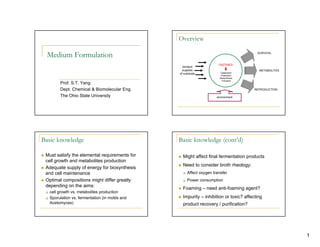
Lecture 3 medium formulation
- 1. Overview Medium Formulation SURVIVAL ENZYMES (limited) supplies METABOLITES of substrate Catabolism Anabolism Biosynthesis Transport Prof. S.T. Yang Dept. Chemical & Biomolecular Eng. REPRODUCTION The Ohio State University environment Basic knowledge Basic knowledge (cont’d) Must satisfy the elemental requirements for Might affect final fermentation products cell growth and metabolites production Need to consider broth rheology: Adequate supply of energy for biosynthesis and cell maintenance Affect oxygen transfer Optimal compositions might differ greatly Power consumption depending on the aims: Foaming – need anti-foaming agent? cell growth vs. metabolites production Sporulation vs. fermentation (in molds and Impurity – inhibition or toxic? affecting Acetomyces) product recovery / purification? 1
- 2. Type of Medium Medium Formulation Defined Substrates Pure chemical components known in exact amount Cheap Expensive Available in large quantity Mostly for research studies Easy to handling Complex (Undefined) Meet nutrient requirements Natural substrates Non-toxic Unknown composition Buffer capability Contains necessary growth factors Ex: corn starch, molasses, whey, soybean meals Less expensive Medium Formulation (cont’d) Medium Formulation (cont’d) Nutrient Supplements Inducers Supplement to the substrate For induced enzymes Ex: methanol for citric acid (help product diffuse Corn steep liquor, malt extract, yeast extract, out of cell) casein hydrolysate, etc. Inhibitors Minerals and Salts To accumulate the metabolic intermediate Buffers: Ex: glycerol Calcium carbonate, phosphate Precursors: Directly incorporated into the desired products Proteins, peptides, amino acids and salts Ex: Penicillin 2
- 3. Industrial Media Nutrient Requirements Carbohydrate Nitrogen o Glucose: - Glucose monohydrate Barley Basic Growth: - Hydrolysed starch Beet molases Water o Lactose: - Pure lactose Corn-steep liquor - Whey Oat flour Energy source o Starch: - Barley Pharma media Carbon source - Groundnut meal Rye flour Nitrogen source (10% – 14% of cell weight) - Oat flour Soybean meal - Rye flour Whey powder Minerals - Soybean meal o Sucrose: - Beet molasses Others: - Cane molasses Growth factors; i.e. amino acids and vitamins - Crude brown sugar - Pure white sugar Oxygen for aerobic growth Energy Sources Carbon Sources Phototrophs: Heterotrophs: Energy from light Carbon for oxidation Use light for ATP formation Mostly carbohydrates (molasses, starch) e.g. Photosynthetic bacteria Can be lipids or proteins Chemotrophs: Autotrophs: Energy from oxidation of medium components: CO2 as carbon source Two classes: Phototrophs: Autotrophs: from inorganic compounds CO2 as carbon source Heterotrophs: from organic compounds 3
- 4. Nitrogen Sources Nitrogen for amino acids, purines, pyrimidines and vitamins Most microorganisms can metabolize inorganic nitrogen, i.e. ammonia or ammonium salts But might grow faster with organic nitrogen Some require organic nitrogen Organic nitrogen compounds: Yeast extract, casein hydrolysate, tryptophan, peptone, corn steep liquor, soybean meal Mineral sources Trace metals Need to be added as distinct components Essential - act as cofactors for enzymes Phosphorous for ATP: phosphate (as buffer) Iron (Fe), Copper (Cu), Cobalt (Co), Sulfur: sulfate, H2S, cystein Manganese (Mn), Zinc (Zn), Molybdenum Magnesium: MgSO4 (Mo) Potassium: KH2PO4, K2HPO4 (as buffer) Some require Selenium (Se) and Nickel (Ni) Calcium: CaCl2, CaSO4 Sodium: NaCl (halophilic bacteria) Present as impurities in major ingredients Chloride: NaCl (halophilic bacteria) Some present in (tap) water 4
- 5. Growth Factors Auxotrophy Vitamins, amino acids, fatty acids Auxotrophs Cannot be synthesized by some cells Lack of one or more biosynthetic pathway Need to be supplied from growth medium Inability to synthesize some organic compounds Prototrophs Ability to synthesize all the needed organic OXYGEN compounds from C sources and salts. From O2 or air e.g. E. coli Act as electron receptor (for aerobic) Fastidious Auxotrophs 20% of cell dry weight Environmental Factors Environmental Factors (cont’d) pH Temperature Acidophiles: pH 2 – 5.5 Mesophiles: 25 – 40 ˚C; optimum: 30 – 37 ˚C fungi Psychrophiles: -5 – 35 ˚C; optimum: 15 – 20 ˚C Thermophiles: 40 – 75 ˚C; optimum: 45 – 60 ˚C Alkalophiles: pH 9 - 12 Extremophiles: 60 – 110 ˚C Neutrophiles: pH 5.5 – 8 Gaseous Requirement (free oxygen) Most bacteria Aerobic (e.g. molds) Optimum 6.5 – 7.5 Anaerobic (e.g., methanogens) Osmolality (Tonicity) Facultative anaerobic (can grow under both aerobic and Osmotic pressure, π = RT(W/Mw) = RTC anaerobic conditions; E. coli, LAB, Yeasts, etc.) 5
- 6. Environmental Factors (cont’d) Environmental Factors (cont’d) Water activity (aw) Amount of free water in the system Oxidation-Reduction (Redox) Potential (Eh) Aw = Ps / Pw The tendency of a solution to give or take up e- Ps = vapor pressure of water in solution Pw = vapor pressure of pure water a (oxidant ) + bH + + ne − ⇔ c(reductant) Aw = MW / (Ms + MW ) Mw = molar concentration of water (55 M) E h = E0 + RT [oxidant ] H + ln a [ ]b Ms = molar concentration of solute nF [reductant ]c Bacteria: > 0.9, G(-) > G(+); F: Faraday quantity of electricity Yeasts: 0.88 Molds: 0.8 halophilic bacteria (~0.75); xerophilic fungi (~0.65); osmophilic Aerobe: (+) mV of Eh bacteria (~0.60) Anaerobe: (-) mV of Eh Environmental Factors (cont’d) Ionic Strength (I) 1 mi: molal concentration of ion I I= Σm i z i 2 Zi: charge 2 NaCl Na+ + Cl- 1 I= ( m + + mCl − ) = m NaCl 2 Na 6
